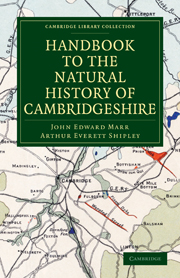Book contents
- Frontmatter
- PREFACE
- Contents
- ADDENDA AND CORRIGENDA
- PHYSIOGRAPHY
- GEOLOGY
- VERTEBRATE PALÆONTOLOGY
- ZOOLOGY
- Mammals
- Birds
- Reptiles and Amphibians
- Fishes
- Mollusca
- Insects: Introduction
- Insects: Orthoptera
- Insects: Neuroptera
- Insects: Hemiptera
- Insects: Coleoptera
- Insects: Lepidoptera
- Insects: Diptera
- Insects: Hymenoptera
- Myriapoda
- Arachnida
- Crustacea
- FLORA
- PREHISTORIC ARCHÆOLOGY
- Appendix to the Article on the Mollusca
- INDEX
- Plate section
Birds
Published online by Cambridge University Press: 10 November 2010
- Frontmatter
- PREFACE
- Contents
- ADDENDA AND CORRIGENDA
- PHYSIOGRAPHY
- GEOLOGY
- VERTEBRATE PALÆONTOLOGY
- ZOOLOGY
- Mammals
- Birds
- Reptiles and Amphibians
- Fishes
- Mollusca
- Insects: Introduction
- Insects: Orthoptera
- Insects: Neuroptera
- Insects: Hemiptera
- Insects: Coleoptera
- Insects: Lepidoptera
- Insects: Diptera
- Insects: Hymenoptera
- Myriapoda
- Arachnida
- Crustacea
- FLORA
- PREHISTORIC ARCHÆOLOGY
- Appendix to the Article on the Mollusca
- INDEX
- Plate section
Summary
INTRODUCTORY
Cambridge and the districts in the vicinity have always been of the greatest interest to ornithologists, owing to the proximity of the Fen country, of old the haunt of many species of Birds which were to be found breeding in few other parts of Britain. The Marsh-Harrier, the Bittern, the Great Bustard, the Ruff and his consort the Reeve, the Black-tailed Godwit, and the Black Tern will doubtless first present themselves to the mind of the reader, as having either entirely or almost entirely ceased to rear their young in the kingdom; but even more remarkable is the case of Savi's Warbler, which was only recognized as a regular summer visitor to the Eastern Counties early in the last century, and disappeared finally from the country in 1856. Bones of Pelican, Swan and Wild Goose have been found in the peat in company with those of commoner species, but with nothing to indicate the exact period to which they belong.
Owing, however, to the gradual drainage of the Fens and the consequent extension of cultivation to large areas formerly occupied chiefly by sallow-bushes, reed-beds and sedges, the state of affairs has entirely changed since the beginning of the nineteenth century, and Cambridgeshire can now lay claim to but little of her ancient glory as a paradise for birds of the moor and morass.
- Type
- Chapter
- Information
- Handbook to the Natural History of Cambridgeshire , pp. 75 - 99Publisher: Cambridge University PressPrint publication year: 2010First published in: 1904

